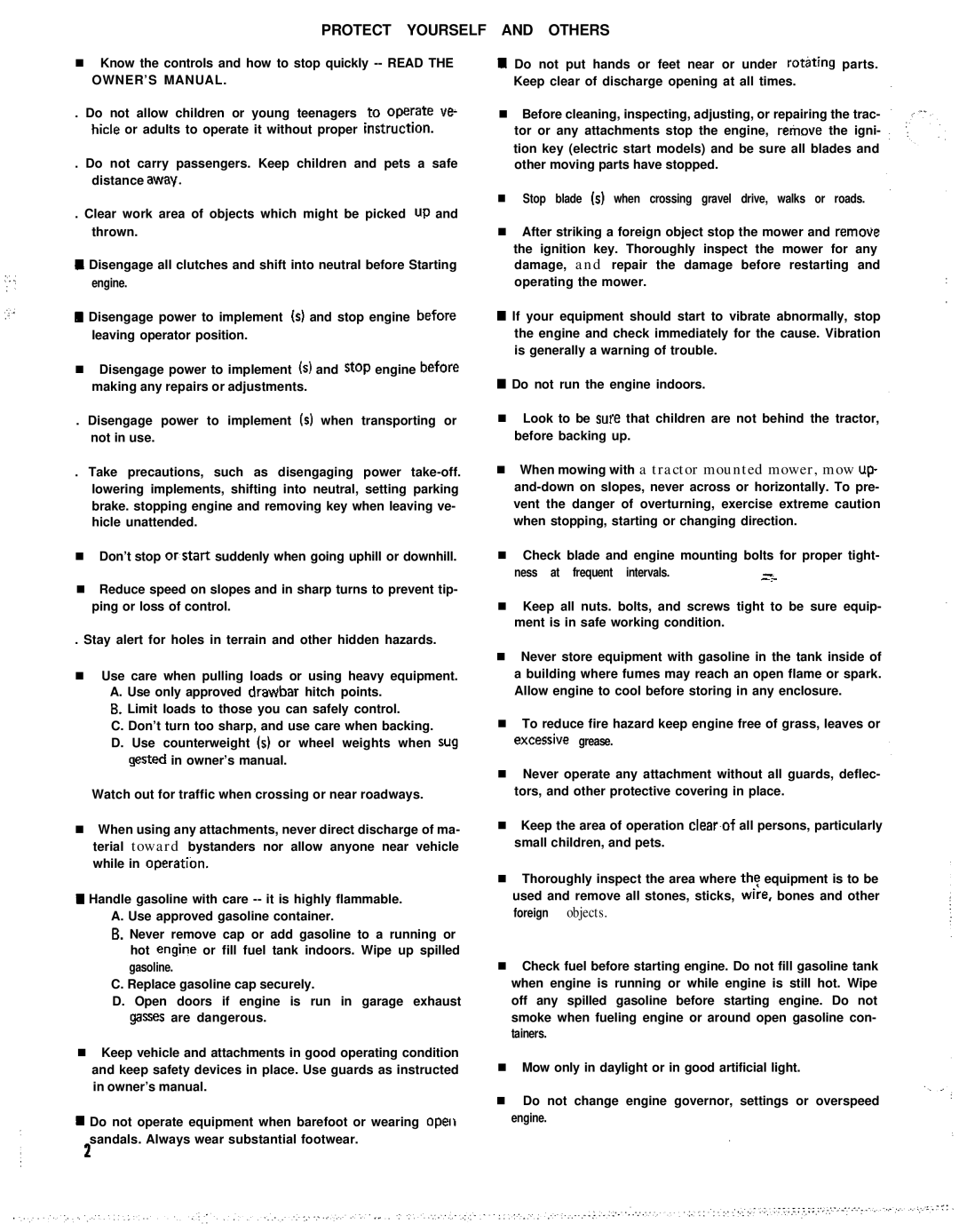
PROTECT YOURSELF AND OTHERS
::: .::
,,:.; ,.,
nKnow the controls and how to stop quickly
. Do not allow children or young teenagers to Operate Ve hicle or adults to operate it without proper inStrUCtion.
. Do not carry passengers. Keep children and pets a safe distance away.
. Clear work area of objects which might be picked UP and thrown.
mDisengage all clutches and shift into neutral before Starting engine.
E Disengage power to implement (9 and stop engine before leaving operator position.
nDisengage power to implement (s) and Stop engine before making any repairs or adjustments.
. Disengage power to implement (s) when transporting or not in use.
. Take precautions, such as disengaging power
nDon’t stop oxtart suddenly when going uphill or downhill.
nReduce speed on slopes and in sharp turns to prevent tip- ping or loss of control.
. Stay alert for holes in terrain and other hidden hazards.
nUse care when pulling loads or using heavy equipment. A. Use only approved drawbar hitch points.
8. Limit loads to those you can safely control.
C. Don’t turn too sharp, and use care when backing.
D. Use counterweight (s) or wheel weights when sug gested in owner’s manual.
Watch out for traffic when crossing or near roadways.
nWhen using any attachments, never direct discharge of ma- terial toward bystanders nor allow anyone near vehicle while in operatitin.
fl Handle gasoline with care
6.Never remove cap or add gasoline to a running or hot engine or fill fuel tank indoors. Wipe up spilled
gasoline.
C. Replace gasoline cap securely.
D. Open doors if engine is run in garage exhaust qanes are dangerous.
nKeep vehicle and attachments in good operating condition and keep safety devices in place. Use guards as instructed in owner’s manual.
w Do not operate equipment when barefoot or wearing open
sandals. Always wear substantial footwear. 2
m Do not put hands or feet near or under rotetins parts. Keep clear of discharge opening at all times.
nBefore cleaning, inspecting, adjusting, or repairing the trac- tor or any attachments stop the engine, reri~ove the igni- tion key (electric start models) and be sure all blades and other moving parts have stopped.
nStop blade 1s) when crossing gravel drive, walks or roads.
nAfter striking a foreign object stop the mower and remove
the ignition key. Thoroughly inspect the mower for any damage, and repair the damage before restarting and
operating the mower.
w If your equipment should start to vibrate abnormally, stop the engine and check immediately for the cause. Vibration is generally a warning of trouble.
W Do not run the engine indoors.
nLook to be sure that children are not behind the tractor, before backing up.
nWhen mowing with a tractor mounted mower, mow up-
nCheck blade and engine mounting bolts for proper tight-
ness at frequent intervals. | =A |
|
nKeep all nuts. bolts, and screws tight to be sure equip- ment is in safe working condition.
nNever store equipment with gasoline in the tank inside of a building where fumes may reach an open flame or spark. Allow engine to cool before storing in any enclosure.
nTo reduce fire hazard keep engine free of grass, leaves or excessive grease.
nNever operate any attachment without all guards, deflec- tors, and other protective covering in place.
nKeep the area of operation clear~of all persons, particularly small children, and pets.
nThoroughly inspect the area where the equipment is to be
used and remove all stones, sticks, wiie, bones and other foreign objects.
nCheck fuel before starting engine. Do not fill gasoline tank when engine is running or while engine is still hot. Wipe off any spilled gasoline before starting engine. Do not smoke when fueling engine or around open gasoline con- tainers.
nMow only in daylight or in good artificial light.
nDo not change engine governor, settings or overspeed engine.
